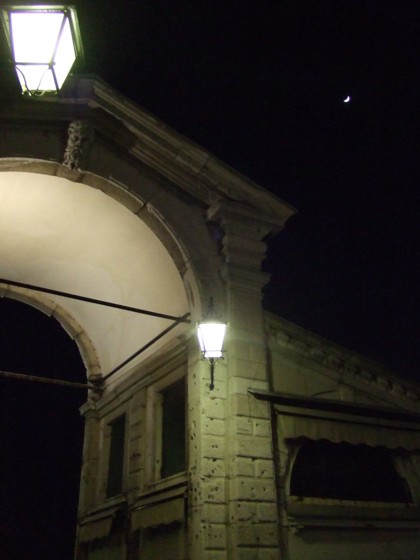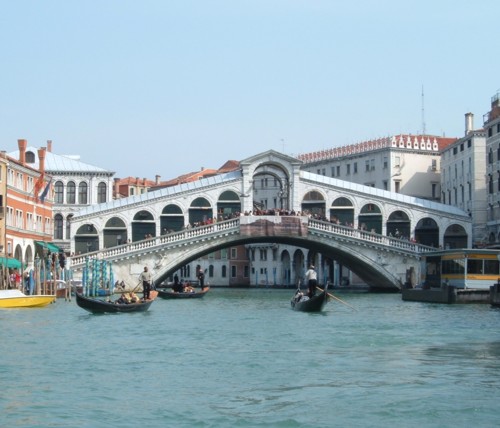The Rialto Bridge (Ponte di Rialto) on the Grand Canal is one of the most well-known sights in Venice, yet sometimes tourists will find themselves upon it by accident. I once heard a young English visitor telling his girlfriend ‘This is it. We’re on the Rialto.’ ‘No we’re not.’ ‘Yes we are!’
There aren’t many stretches of walkway alongside the Grand Canal, so the chances are you’ll arrive at the bridge via some of Venice’s long narrow lanes. You’ll see a flight of steps ahead between yet more buildings, press through the crowds, climb the steps – and there you are at the summit of the famous Rialto Bridge.
The bridge is made of fairly steep flights of steps. Two rows of shops, opening inwards, divide the inner steps from two external balustraded flights. It’s a solid and unromantic construction – I was surprised at the scale on my first trip to Venice. If you are planning a romantic proposal, this isn’t a good spot to choose, unless, perhaps, you visit in the dead of night when the crowds are smaller.
Unlike most tourist attractions, the Rialto Bridge is actually visited by locals, largely because it is such an important crossing-place on the Grand Canal. Venetians stride over the bridge, cutting through the milling tourists and diving into the short-cuts which run behind the rows of souvenir stalls. Standing on top of the bridge as you await an overdue friend, you see all the world go by – including the less attractive faces of tourism: American students attempting to spit onto passing boats; pickpockets arrived in Italy for a life of crime; arguing couples; loitering elderly men vainly hoping to pick up foreign women.
The shops on the Rialto aren’t terribly exciting: they are mostly jewellers and souvenir shops. Climb the exterior sets of steps, though, at the back of the shops, or head through the arches on top of the bridge, and you can really admire the setting, with fine views over the Grand Canal, busy with gondolas and ferries.

History and architecture
This part of Venice, which is built on slightly higher ground, was one of the first centres of habitation and commerce. The name Rialto derives from rivo alto, ‘high bank’. There was always a crossing-point here (the first one a bridge made of boats), and until the 1850s this was the only bridge over the Grand Canal. Nowadays there are four bridges.
In the sixteenth century a competition was held to design a new bridge on the spot. It was to replace the previous structure, a wooden drawbridge which is shown in a lovely painting by Carpaccio in the Accademia gallery (in the Miracles of the True Cross series). Despite competition from famous architects like Palladio, Sansovino and Michelangelo, the competition was won by Antonio da Ponte, and the present Rialto Bridge dates to his 1588 designs. The bridge’s capacity to earn income from shop rents must have appealed to the commercially-minded Venetians.
The bridge has a single span, and is supported at either end by thousands of buried wooden piles. It is surmounted by a double row of small arched shops, crowned with larger central arches allowing pedestrians to pass from the central shopping lane to the panoramic external steps. The bridge is decorated with stone reliefs towards the base. On one side is the scene of the Annunciation, and on the other are Venice’s two patron saints, St. Mark and St. Theodore.
Apparently there used to be a traghetto ferry service across the Grand Canal here, for travellers who couldn’t, or didn’t want to, climb the bridge’s steps.

Location
The Rialto is in the San Polo district of Venice, joining it to San Marco. It’s a central point both within Venice and along the Grand Canal. The vaporetto stop ‘Rialto’ is alongside, and the bridge is easily accessible on foot from pretty much anywhere in Venice. Wherever you go you’ll signs pointing you to the Rialto. It’s about ten minutes’ walk from St. Mark’s.
> More Venice tourist attractions.
On this site
Useful external links
